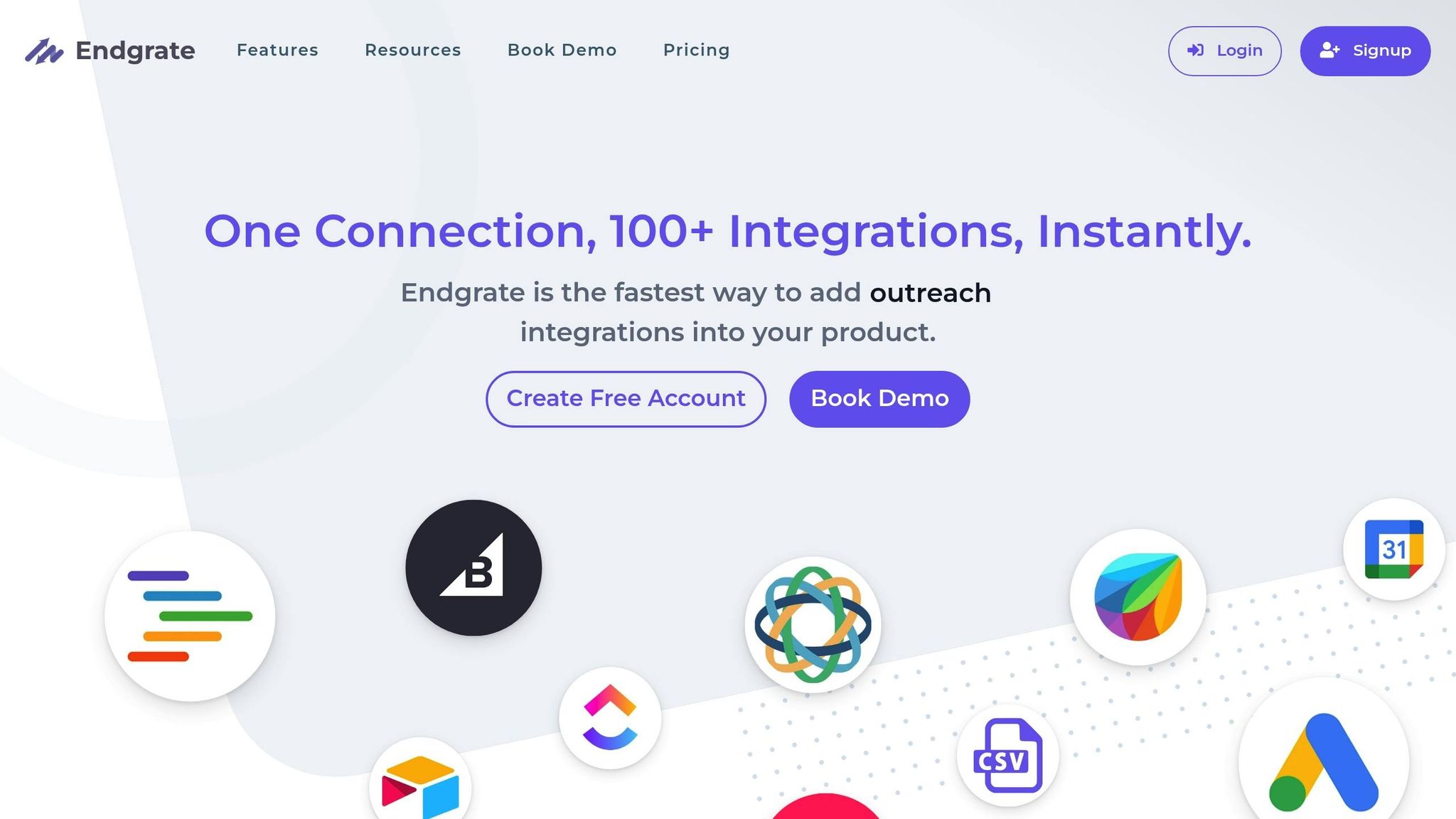Ultimate Guide To Cross-Functional Team Trust

Building trust in cross-functional teams is essential for better collaboration, faster decisions, and improved innovation. When teams like development, marketing, and sales work together effectively, they avoid silos, reduce delays, and achieve shared goals more efficiently.
Key strategies to build trust include:
- Aligning on Shared Goals: Define clear objectives, track progress with measurable KPIs, and maintain accountability.
- Strong Communication: Use regular syncs, shared platforms, and open feedback channels to ensure transparency and clarity.
- Leadership Support: Leaders should promote transparency, resolve conflicts quickly, and celebrate team achievements.
- Practical Activities: Virtual coffee chats, cross-team shadowing, and skills exchange sessions help foster understanding and empathy.
- Integration Tools: Platforms like Endgrate simplify workflows, automate tasks, and improve communication between teams.
Trust isn’t built overnight - it requires consistent effort, feedback, and the right tools to maintain and grow over time. Start applying these strategies to create a collaborative and productive environment for your teams.
How do you build TRUST in a cross-functional product team?
Core Trust Components for Cross-Team Success
Creating trust within cross-functional teams requires a mix of essential elements that encourage collaboration and mutual respect. Let’s break down the main aspects that help establish trust across departments and specialties.
Setting Shared Goals
Aligning on shared objectives is key to building trust between teams. When everyone knows how their role fits into the bigger picture, working together feels more seamless and intentional.
How to Create Clear Goals:
- Define measurable objectives that align with company priorities
- Set transparent KPIs to track progress
- Hold regular check-ins to ensure accountability
- Document and share metrics that show success
Platforms like Endgrate can simplify the process by letting teams focus on strategic priorities instead of getting stuck in technical details. With clear goals in place, open and consistent communication becomes easier.
Building Strong Communication
Good communication is the backbone of trust in cross-functional teams. Teams need the right tools and an environment where ideas can be shared freely.
Best Practices for Communication:
- Schedule regular cross-team syncs
- Keep a record of decisions and next steps
- Use shared communication platforms
- Encourage open discussions
- Provide clear channels for feedback
Psychological safety is a big part of this - team members should feel comfortable raising concerns or proposing new ideas. Clear communication protocols ensure everyone stays on the same page, which also strengthens leadership efforts to build trust.
Trust-Based Leadership
Leadership plays a big role in fostering trust across teams. Leaders set the tone for collaboration and have the power to remove barriers that hinder teamwork.
Leadership Actions That Build Trust:
- Be transparent when making decisions
- Address conflicts quickly and fairly
- Celebrate achievements across teams
- Promote autonomy while ensuring alignment
- Offer tools and resources that support collaboration
When leaders actively support their teams and provide the resources they need, they create an environment where trust can thrive. Their efforts help teams feel valued, leading to stronger, long-term collaboration.
Team Connection Activities to Build Cross-Team Trust
Fostering trust among cross-functional teams requires intentional efforts to encourage interaction and understanding. Here are a few practical ideas to help bridge gaps between teams:
- Virtual Coffee Chats: Set up informal 15-minute meetings where team members can talk about their roles and daily challenges. These quick conversations build familiarity and create empathy across teams.
- Cross-Team Shadowing: Organize opportunities for employees to observe coworkers in other departments. This firsthand experience helps them understand different workflows and appreciate the responsibilities others handle.
- Skills Exchange Sessions: Schedule lunch-and-learn events where team members can share their expertise. These sessions not only spread knowledge but also highlight the importance of everyone's contributions.
Incorporating these activities can help establish trust and strengthen connections between teams.
sbb-itb-96038d7
Integration Tools for Better Teamwork
For teams to work well together across different functions, the right tools are essential. These tools help streamline workflows and create smoother collaboration, which, in turn, builds trust among team members. When technology removes barriers, it strengthens the teamwork strategies outlined earlier in this guide.
Today’s integration platforms simplify data sharing and automate repetitive tasks. This reduces inefficiencies and helps departments work together more effectively. One standout option is Endgrate, a platform designed to connect teams efficiently.
Using Endgrate for Team Collaboration

Endgrate offers a unified platform with several benefits for cross-functional teams:
- Simplified Workflow Management: Endgrate takes care of complex system integrations, allowing teams to focus on their main tasks without getting bogged down by technical issues.
- Faster Development Process: With access to over 100 integrations through a single API, Endgrate eliminates the need to manage multiple systems. This approach reduces technical challenges, speeds up project timelines, and lowers dependency between teams.
- Improved Communication: By standardizing data handling, Endgrate ensures that information flows smoothly between departments, making collaboration clearer and more effective.
- Flexible Solutions: Whether using custom or predefined data models, Endgrate adapts to existing workflows while addressing the specific needs of each team.
Tracking and Maintaining Team Trust
Once you have effective tools in place, keeping an eye on team trust becomes just as important. Building trust across different teams isn’t a one-and-done task - it needs regular attention and evaluation to stay strong.
Getting Team Input
To measure trust effectively, combine numbers with personal insights. Structured surveys and open conversations can reveal a lot about how your team is functioning.
Here are some useful ways to gather feedback:
-
Anonymous Trust Surveys: Conduct these quarterly to assess key areas like:
- How well teams communicate
- The quality of collaboration across departments
- Satisfaction with shared resources
- Transparency in decision-making
- How effectively conflicts are resolved
-
Monthly Team Retrospectives: Dedicate time each month for teams to:
- Discuss collaboration challenges
- Celebrate successful joint efforts
- Suggest ways to improve processes
- Address any new concerns
- Cross-functional Focus Groups: Every two months, bring together representatives from different teams to talk about trust-related issues and brainstorm solutions.
The feedback you collect can guide ongoing improvements.
Making Regular Improvements
Feedback is only useful if it leads to action. Use the input to make meaningful changes and acknowledge progress along the way.
Steps to Strengthen Trust:
-
Document Lessons from Successes
Build a shared database that highlights examples of effective cross-team efforts. Include:- How conflicts were resolved
- Outcomes of successful joint projects
- Process changes that boosted trust
-
Celebrate Wins
Recognize achievements that showcase great collaboration, whether big or small. For example:- Shout out teams that consistently meet shared goals
- Highlight departments that go above and beyond to support others
- Share positive feedback from stakeholders about teamwork
-
Offer Regular Training
Host quarterly sessions to help teams improve skills like:- Active listening
- Communicating across different cultures
- Managing conflicts
- Solving problems together effectively
Conclusion
Establishing trust within cross-functional teams is a key factor in achieving success in today’s fast-paced market. Teams that prioritize trust are more productive, experience fewer conflicts, and come up with better solutions.
This trust leads to practical advantages like higher efficiency and a sharper focus on priorities. Tools like Endgrate can simplify team integration and help maintain a competitive edge.
Building lasting trust involves:
- Consistent Leadership Support: Leaders need to actively promote trust-building efforts and set an example through their actions.
- Regular Assessment: Continuously evaluate trust levels using structured feedback to identify areas for improvement.
- Flexible Processes: Adjust collaboration methods to meet the changing needs of the team.
- Technology Enablement: Use the right tools to ensure effective communication and smooth workflows.
Related posts
Ready to get started?
